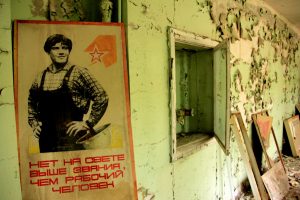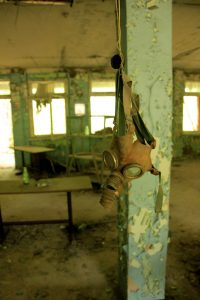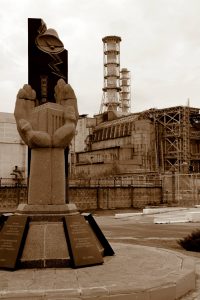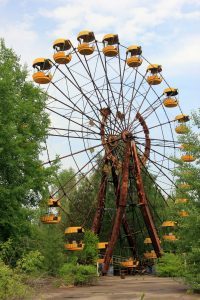 Today I had lunch in Chernobyl. Probably one of the most unlikely phrases I have uttered, but I did, indeed, munch upon salad, soup, meat, rice and pancakes whilst sat in the Chernobyl staff canteen. The canteen was as typical as any institutional dining hall: the scene from the window less so. Wide, empty streets suggested a place devoid of the original objective for which it had been built, but the odd, most-commonly male, person, striding past with a lanyard swinging from his neck, implied this was a town which still had business to do.
Today I had lunch in Chernobyl. Probably one of the most unlikely phrases I have uttered, but I did, indeed, munch upon salad, soup, meat, rice and pancakes whilst sat in the Chernobyl staff canteen. The canteen was as typical as any institutional dining hall: the scene from the window less so. Wide, empty streets suggested a place devoid of the original objective for which it had been built, but the odd, most-commonly male, person, striding past with a lanyard swinging from his neck, implied this was a town which still had business to do.
Chernobyl is not the exact location of site of the nuclear accident that occurred in the early hours of 26 April 1986, but it was the nearest large town to the power plant and, it seems, continues to mop up the consequences.
My journey began with a ninety minute minibus drive from Kiev to the first military checkpoint at the edge of the Chernobyl ‘exclusion zone’, some 30 km away from the power station. Our passports were scrutinised as thoroughly as at any airport (we had to submit our passport numbers 15 days beforehand) and our government-employed Ukrainian tour guide hopped into our bus. Now twenty-four years old, he was born after the accident, but became a ‘Chernobyl Child’ when he was three years old, as the small village where he had been born and lived was declared within the enlarged exclusion zone in 1993.
As we drove along the tarmac road that stretched out before us, so empty that it might have been built for our exclusive use, the guide pointed out the odd wooden dwelling and many mounds, each with radioactive signs perched on top, in the surrounding woodland. These were the remains of some of the 196 villages evacuated from this region. Some villagers, we were told, have since returned to their dwellings. An 85-year-old woman, apparently, can frequently be seen walking through these woods to and from Chernobyl town to do shopping. I wondered how anyone could prefer to be neighbours with lethal doses of radiation than live in the towns to which they had been resettled, however unwelcoming they might have found them. Most of the houses, however, were dismantled and buried in the ground, along with their layers of radioactive dust that gathered on them. An expedient measure which might yet prove to be costly: there is, apparently, the danger that the radiation from these mounds might one day leech down into the region’s aquifer.
 Our first stop of the day was an abandoned nursery. We left the security of the minibus and trampled an overgrown path towards a dilapidated one-story building. The surrounding playground was a mass of leaves, with rubber tyres, a record-player and a single plastic doll poking through. These dolls, with the odd missing arm or leg, have become such an icon of so many photos of Chernobyl that, for the first time, I realised I was actually, finally, standing on the soil of a place that had assumed mythic proportions in my mind. Although, after seeing a few more strategically placed dolls, I figured these objects were perhaps less symbolic of the passage of time and more that of someone setting up a good photo opportunity. Inside, was the furniture of a typical nursery: posters, bookshelves, toilets and beds (presumably this was a nursery for very young infants). There were a row of lockers, each with their door open. I concluded these were signs of how each child’s belongings had been pulled out in great haste in 1986; but as we progressed on our tour, I reflected that more likely they had been visited by looters. Looters, we were to see time and again, were not fazed by the risk of radiation poisoning.
Our first stop of the day was an abandoned nursery. We left the security of the minibus and trampled an overgrown path towards a dilapidated one-story building. The surrounding playground was a mass of leaves, with rubber tyres, a record-player and a single plastic doll poking through. These dolls, with the odd missing arm or leg, have become such an icon of so many photos of Chernobyl that, for the first time, I realised I was actually, finally, standing on the soil of a place that had assumed mythic proportions in my mind. Although, after seeing a few more strategically placed dolls, I figured these objects were perhaps less symbolic of the passage of time and more that of someone setting up a good photo opportunity. Inside, was the furniture of a typical nursery: posters, bookshelves, toilets and beds (presumably this was a nursery for very young infants). There were a row of lockers, each with their door open. I concluded these were signs of how each child’s belongings had been pulled out in great haste in 1986; but as we progressed on our tour, I reflected that more likely they had been visited by looters. Looters, we were to see time and again, were not fazed by the risk of radiation poisoning.
We then drove into Chernobyl town centre to see two memorials to the disaster. The first, an arch angel constructed from iron spokes, harking over a series of crosses, each representing one of the towns evacuated in the region. The second was a monument to the firemen who were killed in the disaster. These men were the first on the scene after fire broke out at the reactor, and died rapidly from radiation sickness.
In many ways, monuments in this region felt redundant. Monuments are society’s way of remembering events or people, yet, given only a very limited population ventures into this area, these structures can’t be reminding many people. And of those who did see them, there was, and will always be, just further down this road a much greater structure that will be ever-present on this landscape.
 Six reactors make up Chernobyl nuclear power station. Three are being decommissioned (although they continued to function years after the nuclear accident in 1986), number four went into meltdown and the last two were never put to use. We drove a large circle round the complex before parking, probably about two hundred metres away from reactor four. Currently some 30,000 work and live in this area, although they work and live by halves, having 15 days in the exclusion zone and 15 days out of it, to limit the amount of radiation their bodies absorb. They are responsible for the decommissioning process, preventing leakages from reactor four and for building an enormous dome, which currently sits adjacent to reactor four, but which will be slid on top of the existing structure in three years times. I’m sure it will be the biggest, thickest, heaviest plaster that man has ever made.
Six reactors make up Chernobyl nuclear power station. Three are being decommissioned (although they continued to function years after the nuclear accident in 1986), number four went into meltdown and the last two were never put to use. We drove a large circle round the complex before parking, probably about two hundred metres away from reactor four. Currently some 30,000 work and live in this area, although they work and live by halves, having 15 days in the exclusion zone and 15 days out of it, to limit the amount of radiation their bodies absorb. They are responsible for the decommissioning process, preventing leakages from reactor four and for building an enormous dome, which currently sits adjacent to reactor four, but which will be slid on top of the existing structure in three years times. I’m sure it will be the biggest, thickest, heaviest plaster that man has ever made.
The sarcophagus that currently surrounds the reactor, built in haste in 1986, is currently leaking huge doses of radiation, as our guide more than ably demonstrated. As we walked towards the reactor four, and up to another memorial, this time dedicated to the destruction of the reactor itself, the gigametre started bleeping, and then went into overdrive, just as would parking sensors on a car, if one decided to something as stupid as to reverse into a concrete wall. Instead, we were doing something as stupid as voluntarily walking into an invisible mass of radiation. What our guide next did made me feel acutely uncomfortable. He turned his back to the reactor, shielded the gigametre with his body, and the radiation levels began to decrease: his body was doing the absorbing and shielding, protecting the gigametre. I found myself instinctively taking a few steps back and then consciously take a few more. I was more than pleased to return to encase myself back inside our vehicle.
After a visit to the reactor came the reason for my trip: a visit to Pripyat, three kilometres from the reactor. This town was purpose-built for the power plant’s employees and my main reason for visiting Chernobyl. Its 43,000 residents were evacuated via 1,100 buses sent from Kiev over 3.5 hours on Pripyat some forty hours after the accident had occurred.
 Passing through our second military checkpoint of the day, we drove along what would have been the main road into the town. Trees had reduced it from a dual to single carriageway, and soon it wouldn’t even be as wide as that. We parked in what was once the central square, and set off on foot for our tour. First we visited the famous ferris wheel, another icon of Chernobyl, then we entered a secondary school, next an apartment block and finally a sports centre. These were the few remaining buildings left in the town that were structurally sound enough for us to enter.
Passing through our second military checkpoint of the day, we drove along what would have been the main road into the town. Trees had reduced it from a dual to single carriageway, and soon it wouldn’t even be as wide as that. We parked in what was once the central square, and set off on foot for our tour. First we visited the famous ferris wheel, another icon of Chernobyl, then we entered a secondary school, next an apartment block and finally a sports centre. These were the few remaining buildings left in the town that were structurally sound enough for us to enter.
The memorisation I experienced in these buildings, and this whole town, was, I think, for three reasons. First, this was a chance to see a communist town frozen in time. I’ve always wished I could have visited the eastern block, but I was twelve years old when the USSR collapsed. This was the next best thing. The school, in particular, immersed me in this dying ideology. The hundreds of chidren’s gas-masks strewn across the floor of the dining room (presumably by looters) were an acute reminder that, when it was last used, people believed a nuclear war was imminent. Upstairs there were wonderful posters of Lenin greeting working men, or a proud labourer in overalls, presumably taking pride in his manual employment.
I was also in awe of this place simply because it took me back to 1986. I found myself indulging my vintage tastes as I admired the wall case in one apartment, fancying it in my living room. I was less enamoured with the plastic coated wall paper in another, which had a red-brick pattern printed on it, as if to give the impression of an external wall.
But, finally, I was captivated by this town bereft. There was enough intact so that one could easily imagine what it once was, and enough, therefore, to still make its inhabitants feel acutely missing. I think the swimming pool summed it up best. One so rarely sees a public swimming pool empty that it looks so odd when drained of water. A 50-metre pool, three diving boards, the deep slope half way down in the deep end, and the ladders at the deep end, each leading to nothing. Everything was there, apart from the purpose for which it had been built: to hold swimmers and water.
Perhaps the desolateness was linked to the strange feeling of serenity and peace that I also felt in this town. This surprised me given that I was in an area that so literally oozed hazard and danger, and which also was responsible for the suffering upon hundreds or thousands of people. It took me a while to explain this feeling to myself, but I think it was this: nature seemed so much at ease in this area. It had already, with impressive speed, reclaimed much of the land, the roads, and the buildings. The cuckoos were the most powerful voice here. Man, meanwhile, in his quest for more energy, and whilst he plunders so many of the Earth’s resources, we had banished himself in perpetuity from this area. The half-life of the plutonium that leaked from the reactor is 24,000 years and only after thirty half-lives, or 720,000 years, is it likely that this area will once more be habitable for humans. I contemplated the irony of this as I wondered back to our minibus, as I did the irony of going off to do something as mundane and ordinary as having lunch in Chernobyl.
